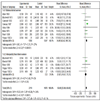Effect of balanced protein energy supplementation during pregnancy on birth outcomes
- PMID: 21501434
- PMCID: PMC3231890
- DOI: 10.1186/1471-2458-11-S3-S17
Effect of balanced protein energy supplementation during pregnancy on birth outcomes
Abstract
Background: The nutritional status of the mother prior to and during pregnancy plays a vital role in fetal growth and development, and maternal undernourishment may lead to adverse perinatal outcomes including intrauterine growth restriction (IUGR). Several macronutrient interventions had been proposed for adequate protein and energy supplementation during pregnancy. The objective of this paper was to review the effect of balanced protein energy supplementation during pregnancy on birth outcomes. This paper is a part of a series of reviews undertaken for getting estimates of effectiveness of an intervention for input to Lives Saved Tool (LiST) model.
Methods: A literature search was conducted on PubMed, Cochrane Library and WHO regional data bases to identify randomized trials (RCTs) and quasi RCTs that evaluated the impact of balanced protein energy supplementation in pregnancy. Balanced protein energy supplementation was defined as nutritional supplementation during pregnancy in which proteins provided less than 25% of the total energy content. Those studies were excluded in which the main intervention was dietary advice to pregnant women for increase in protein energy intake, high protein supplementation (i.e. supplementation in which protein provides at least 25% of total energy content), isocaloric protein supplementation (where protein replaces an equal quantity of non-protein energy content), or low energy diet to pregnant women who are either overweight or who exhibit high weight gain earlier in gestation. The primary outcomes were incidence of small for gestational age (SGA) birth, mean birth weight and neonatal mortality. Quality of evidence was evaluated according to the Child Health Epidemiology Reference group (CHERG) adaptation of Grading of Recommendations Assessment, Development and Evaluation (GRADE) criteria.
Results: The final number of studies included in our review was eleven comprising of both RCTs and quasi-RCTs. Our meta-analysis indicates that providing pregnant females with balanced protein energy supplementation resulted in a significant reduction of 31 % in the risk of giving birth to small for gestational age infants (Relative risk (RR) = 0.69, 95% Confidence interval (CI) 0.56 to 0.85). This estimate had been recommended for LiST as a proxy for reduction in IUGR. Pooled results for mean birth weight showed that balanced protein supplemented group gained more weight compared to control [Mean difference 59.89 g, 95 % CI 33.09-86.68]. This effect was more pronounced in malnourished women compared to adequately nourished women. There was no statistically significant effect of balanced protein energy supplementation on neonatal mortality (RR= 0.63, 95% CI 0.37 to 1.06).
Conclusion: Providing pregnant females with balanced protein energy supplementation leads to reduction in risk of small for gestational age infants, especially among undernourished pregnant women. Given these findings, we can recommend balanced protein energy supplementation as an intervention among undernourished women for inclusion in the LiST model with a point estimate of 31% [95% CI 15% to 44%] reduction in IUGR.
Figures




References
-
- de Onis M, Blossner M, Villar J. Levels and patterns of intrauterine growth retardation in developing countries. Eur J Clin Nutr. 1998;52(Suppl 1):S5–15. - PubMed
-
- Ashworth A. Effects of intrauterine growth retardation on mortality and morbidity in infants and young children. Eur J Clin Nutr. 1998;52(Suppl 1):S34–41. discussion S41-32. - PubMed
-
- Ferro-Luzzi A, Ashworth A, Martorell R, Scrimshaw N. Report of the IDECG Working Group on effects of IUGR on infants, children and adolescents: immunocompetence, mortality, morbidity, body size, body composition, and physical performance. Eur J Clin Nutr. 1998;52(Suppl 1):S97–99. - PubMed
-
- Martorell R, Ramakrishnan U, Schroeder DG, Melgar P, Neufeld L. Intrauterine growth retardation, body size, body composition and physical performance in adolescence. Eur J Clin Nutr. 1998;52(Suppl 1):S43–52. discussion S52-43. - PubMed
-
- Prada JA, Tsang RC. Biological mechanisms of environmentally induced causes of IUGR. Eur J Clin Nutr. 1998;52(Suppl 1):S21–27. discussion S27-28. - PubMed
Publication types
MeSH terms
Substances
LinkOut - more resources
Full Text Sources
Medical
Molecular Biology Databases

